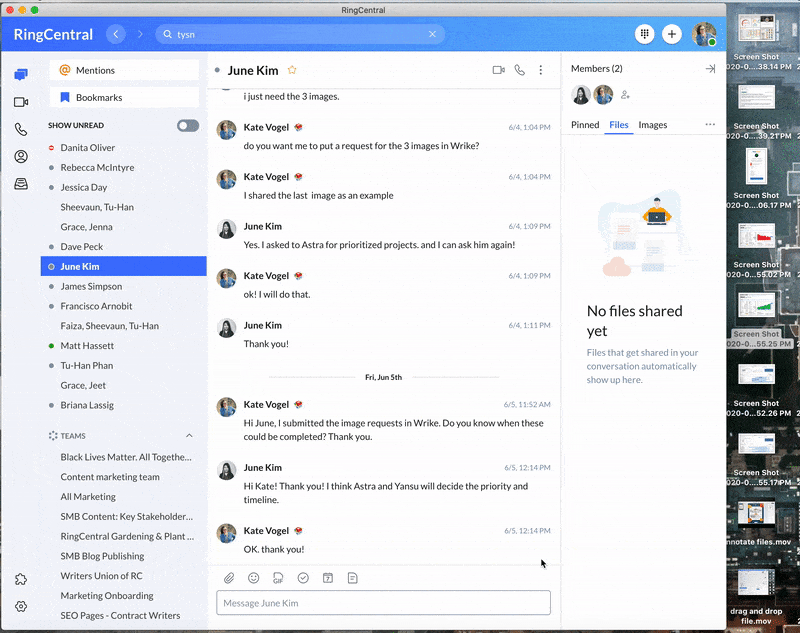If you’re looking into a hybrid work model for your small business, you aren’t alone.
In a recent CNBC survey, around half of the senior HR execs questioned said they plan to use a hybrid work model going forward. Employee mental health and wellness were cited as top reasons for this post-pandemic decision, followed by employee productivity. Employees are also attracted to a hybrid work model, with 47% saying they’d look for another job if their current employer doesn’t offer this mode of working.
Today, we’ll cover everything you need to know about creating a hybrid work model for your business:

What is a hybrid work model?
In 2020, the buzz was all about remote work. Fast forward, and it seems all that managers and teams can talk about are the benefits of a hybrid work model. Organizations are considering their options on how they can combine remote employees with office employees, working from more traditional workplaces.
So, what exactly is a hybrid work model?
Put simply, a hybrid work model is one that incorporates a mixture of in-office and remote working within an employee’s schedule. In some models, office workers have the ability to choose when they will work from home and when they will work from the office. In other models this is dictated for them.
In fact, there’s no one clear definition of a hybrid model—they can come in many shapes and forms. Each company needs to decide on the alternative that best suits their needs and the needs of their employees.
The benefits of a hybrid workplace
There are many benefits of moving to a hybrid workplace including:
There are, of course, potential pitfalls when it comes to implementing a hybrid work model, too, so it’s important to make sure you have the right technology and support in place.
Different hybrid work models
It’s not always easy to know what kind of hybrid work will be best for your team. To help you decide, we’ve outlined some examples, along with tools that will ensure your transition to hybrid working runs smoothly.
Remote-first
In a remote-first hybrid model, while office spaces will still be available to employees, most people will be able to work remotely. There have to be some exceptions to this rule because some workers will need to have a physical presence in order to fulfill their duties, such as maintenance staff, etc.
While remote-first will look different for different companies, the chief principle is that the business acts like a fully remote company.
This model offers companies benefits in terms of drastically expanding their hiring pool while reducing costs—in terms of office rental, commuting, and costly on-site office hardware. That’s because remote employees will likely be using remote, cloud-based technology. Cloud computing makes it easier to collaborate with colleagues and clients no matter where they’re based.
RingCentral, for example, offers a cloud communications system. This enables companies to add multiple locations and manage their remote workforce as well as mobile and contract workers.
Employees can make and take calls using the main business number or their direct line on desk phones, personal smartphones, home telephones, or even hotel phones (using RingCentral’s RingOut feature). Companies adopting a remote-first mentality can also organize annual retreats or work get-togethers to ensure teams stay connected.
Tools to support you in a remote-first environment
Cloud communications platforms offer a host of useful tools to help companies go remote-first and ensure that remote teams can stay organized and productive when they’re not sharing a physical space.
From video conferencing and team messaging to a robust phone system, RingCentral’s user-friendly interface helps boost teamwork and lets teams stay connected in real time, regardless of where they’re situated in the world and across all time zones. Plus, everything lives inside the same easy-to-use app, so no conversations ever fall through the cracks.
Office-encouraged
In this work arrangement, employees can work remotely, but they’re encouraged to come to the office at least a few times a week. They can often choose how they want their workday to look—such as when they want to work remotely and when they want to spend time on office work with their teammates.
This enables both face-to-face and remote collaboration between coworkers. This model is a happy medium for employers when it comes to maintaining face-to-face time and workforce camaraderie, while offering the flexibility employees crave.
Microsoft, for example, allows employees to work from home at least 50% of the time, but workers can increase their remote schedule with their manager’s approval. Microsoft also said they’d switched from focusing on their office-based staff to staff working remotely.
While this approach is a good option for many staff, it may not have the flexibility required by top talent.
Office-first with remote options
Remote working is not a new concept and pre-pandemic some companies allowed certain members of staff to work from home. This model dictates that the majority of staff will return to the office full-time with a minority working from another location.
Some companies prefer this model because they believe that when staff are co-located they’re better at developing human connections with others, and feel a better sense of belonging. If you’re thinking of implementing an office-first model there are some things to consider:
6 tips to implement a successful hybrid work model
All of these hybrid work models have their pros and cons. It’s essential that you have policies and processes in place to fit your specific hybrid environment.
Here are some ways to ensure your hybrid work model delivers for you, no matter which one you choose:
1. Create clear expectations
Setting clear expectations around hybrid working so that everyone is on the same page is a prerequisite. It’s also important to review your hybrid working policies on a regular basis. When you’re hybrid work strategy consider, for example:
- Whether some meetings are better in person or by video. Some meetings are simply better held physically in meeting rooms. Whether it’s a client meeting, a big sales initiative rollout, a rebrand of a product, or any other important event. Hosting an in-person meeting is a powerful way to illustrate the importance of the meeting.
- Projects requiring face-to-face collaboration. With RingCentral video meetings, it’s possible to screen share and add notes “in the moment,” making these meetups as near to a physical meeting as possible. Having said that, there are occasions when working together in a physical space is preferable in order to create connections between team members.
- Conducting interviews. Remote screening tools are now used regularly as part of the recruitment process, and it’s a useful way to interview lots of people—as well as saving time. However, when recruiting for a hybrid team member, a face-to-face interview can give you a more in-depth understanding of their personality and how they might fit within the business.

Read the blog
Whatever your work policy, make sure to ensure there’s transparency across the board and give everyone the opportunity to ask questions.
2. Invest in remote technology now, not later
Investing in the right remote working tools plays an important part in whether your hybrid work model will work successfully or not. Especially when it comes to collaboration.
RingCentral has an entire suite of tools aimed to boost collaboration both in the office and when working remotely. With the right tools you can host virtual meetings both internally and with customers, which are always effective and efficient.
Besides the option to host video calls, RingCentral also offers remote technology for sharing files and screens, as well as assigning tasks. Instead of having to switch from system to system, everything can be completed from one place:

3. Help your hybrid team feel connected
It’s important to ensure that remote workers are not “siloed”, and that they don’t miss out on important decisions or find it difficult to access advice and help.
To help ensure remote workers feel they’re part of the equation, an investment into a robust form of video conferencing software is recommended.
RingCentral delivers HD video meetings that make everyone feel like they’re in the same conference rooms, whether they’re in the office or working remotely. It’s also possible to keep the conversation going after the meeting with built-in team messaging. With RingCentral it’s also possible to connect your favorite apps, such as Google Workspace and Microsoft 365 or Microsoft Teams, and start meetings from them.
4. Ensure all team members are focused
Staff on work-from-home days in an office-centric hybrid might see their out-of-office days as time to focus more on personal projects rather than collaboration with others.
This differs from a remote-first hybrid model, where teams may only be in the office one to two days per week. They need to think “hybrid collaboration first”, both in and out of the office.
So, if you’re thinking of moving to this hybrid model, consider whether your teams can get by by treating remote days in this way.
5. Offer office-first staff more flexibility
When implementing an office-first work environment, it’s important not to be too rigid about the hours worked. Some people work better early in the morning, others later in the day.
Offering workers the flexibility to set their own hours could help mitigate the frustration some employees may be experiencing at having to return to a pre-pandemic model. Allowing staff to get involved in the decision-making process and set their own schedules could also help to prevent burnout and create a better work-life balance.
6. Review office perks
Remote work frees up a significant amount of budget, so this could be a good time to review how you’re planning to reward employees. Look at different delivery services for special occasions, discounted gym memberships and childcare, and commuter and lunch stipends.
Rewarding employees working on a hybrid basis is a great way to keep them more engaged and motivated, as well as to boost retention rates. Staff working from home can be rewarded as well as made more productive with home office reimbursements. Home office setups are often less than fit for purpose and can lead to any number of health issues for employees.

Read the blog
Giving hybrid workers the funds to buy ergonomic chairs, for example, will prevent them from injury and boost job satisfaction levels.
When you’re reviewing your office perks, ask staff what they want. Carry out surveys to stop the guesswork. Even asking them their opinions is a form of recognition. It’s also important to remember that remote working is not, in itself, a reward. Workplace flexibility isn’t a perk, it’s now an expectation.
Which hybrid work model will you choose?
The three models we’ve outlined in this article each come with their own distinct implications. Whichever model (or mixture of models) you find most suitable, you need to consider not only the setup of a hybrid work environment, but how it affects your company culture, leadership, and compensation levels.
There’s no time to waste when it comes to thinking about your new hybrid work model, the sooner you embrace these changes the sooner everyone can start adapting to this new reality.
Creating a hybrid work model has never been easier with the help of RingCentral’s hybrid work solutions.
Looking For Startup Consultants ?
Call Pursho @ 0731-6725516
Telegram Group One Must Follow :
For Startups: https://t.me/daily_business_reads







